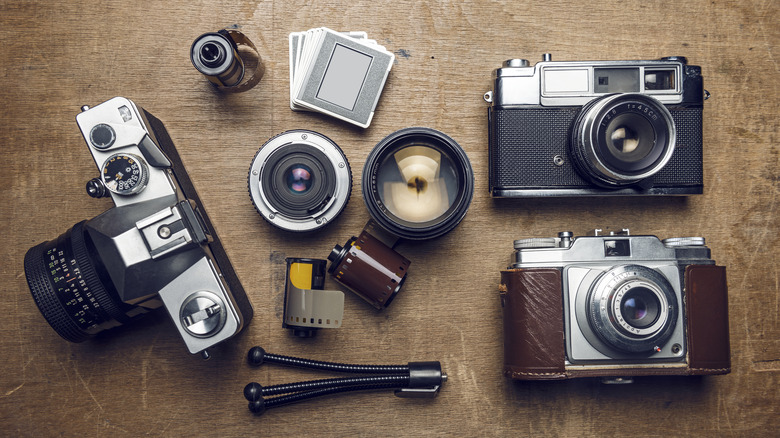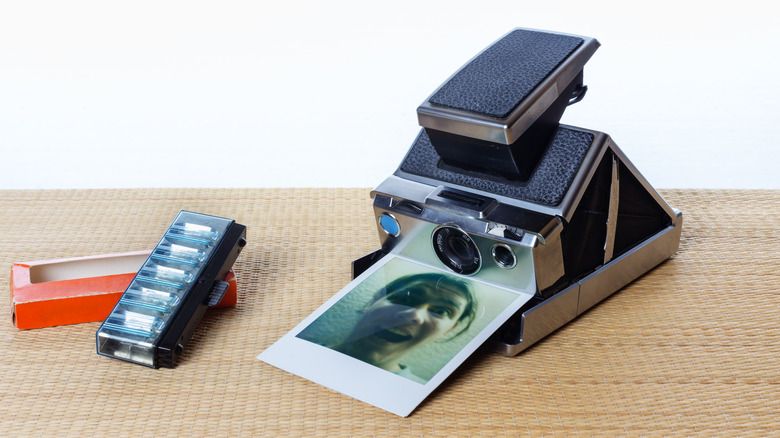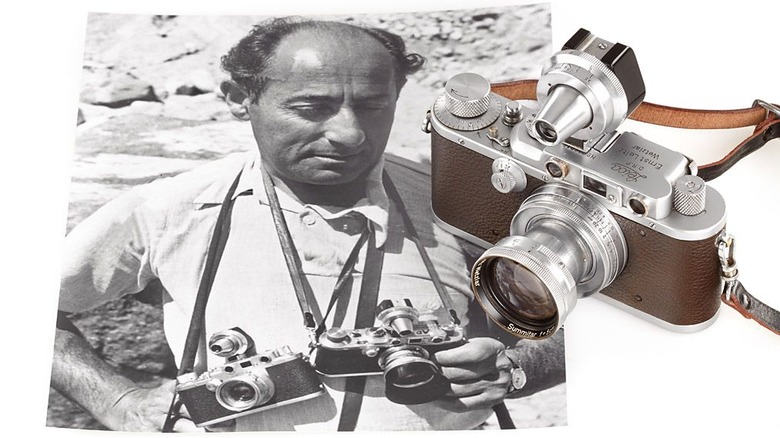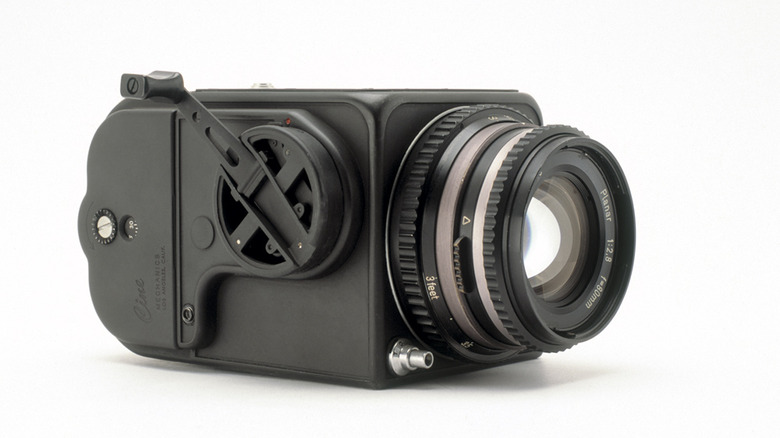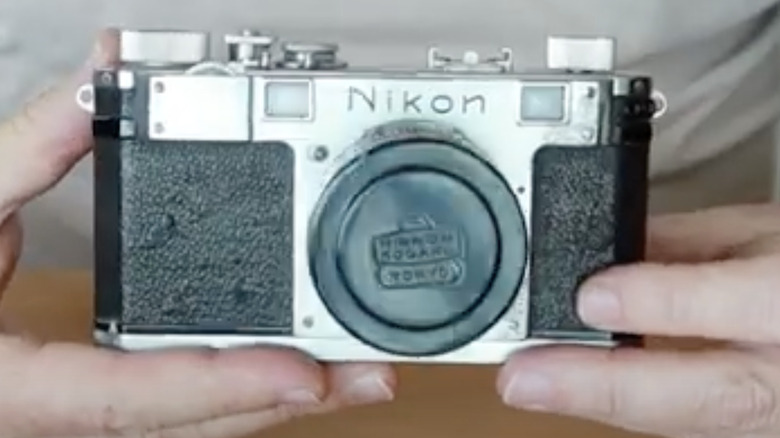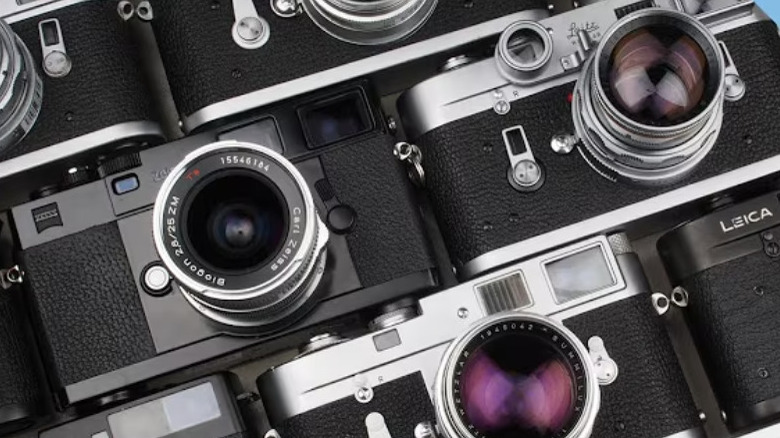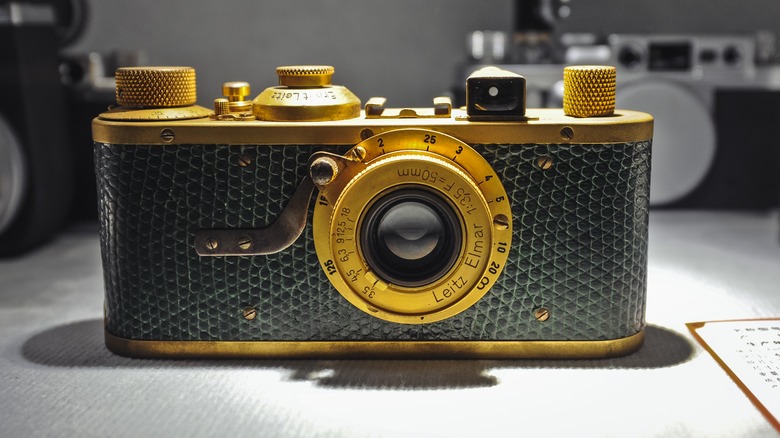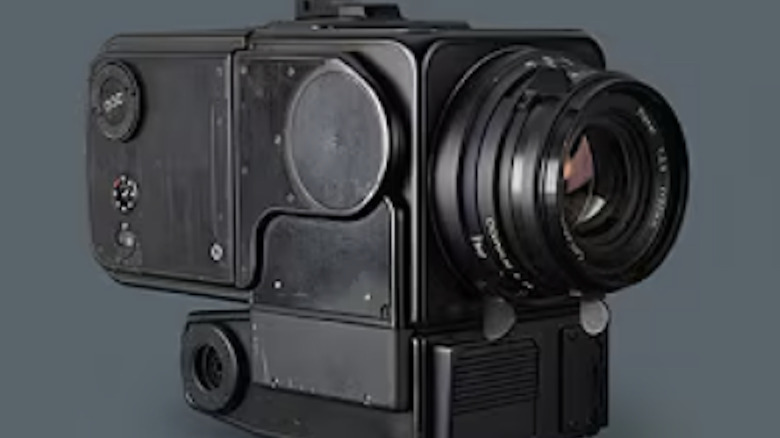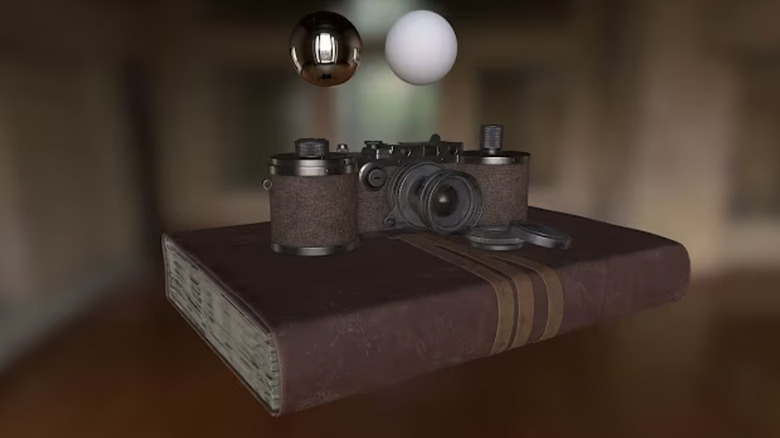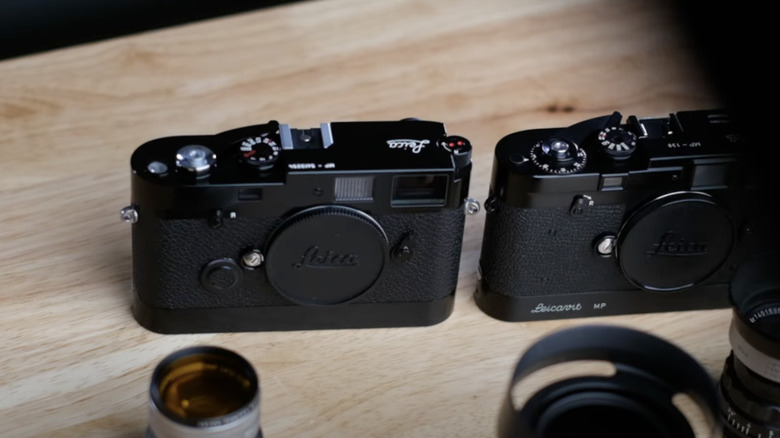These Old Cameras Are Actually Worth A Ton Of Money
In the fascinating realm of collectibles, the trifecta of scarcity, rarity, and historical significance reigns supreme. This principle makes classic cars so valuable because they were immortalized by celebrated movies or represented iconic eras like the 1960s. With photographic cameras, particularly film models, it's almost the same. They carry an enchanting aura, capturing fleeting moments, freezing time, and keeping alive emotions that echo across decades. Imagine touching the very shutter Alfred Eisenstaedt pressed for the famous 1945 "V-J Day Kiss" photo in New York — one of many photographs worth a ton of money — or cradling the first Nikon ever made. It is as though you're holding a heartbeat of history.
Yet, these precious relics often languish forgotten in dusty attics, are nonchalantly sold at garage sales, or worse, end up in the rubbish bin as if worthless. Discarding such treasures borders on criminal negligence. Before you let your kids play with Granddad's vintage camera, take a moment to reflect on its history. Did you know that an antique rangefinder or SLR camera gathering dust could be your golden ticket? If you own one, consider having it appraised by a professional. And if you're thinking of entering the collectibles market yourself, be aware that buying antiques online is risky without the proper knowledge. It is better to buy and sell face-to-face. So, step back in time and delve into the life of that old camera. You might be surprised at the stories — and value — it holds.
Andy Warhol's Polaroid SX-70 instant camera, 1970s — $13,750
For those unfamiliar with Andy Warhol (1928-1987), he was a groundbreaking American visual artist who became a central figure in the 1960s-1970s Pop Art movement. Warhol's most famous works include the design of the Campbell's Soup Cans series, the Marilyn Monroe Diptych, and vibrant screen-printing portraits of celebrities including Elvis Presley, Elizabeth Taylor, Mick Jagger, and Mao Tse-Tung. But why is this Polaroid important? The SX-70 was the first instant SLR (single-lens reflex) folding camera. You looked through the viewfinder for framing, took the shot, and the camera would automatically eject a self-developing color photo that appeared within minutes. It was innovative back then since, with a normal 35 mm, after snapping your shot, you had to visit a photo studio for developing and printing.
In a flash, it became a cult favorite, in particular among artists, for its immediacy and the distinctive soft, dreamy look of its prints. An iconic image is Warhol's self-portrait in a mirror with his SX-70. Value-wise, an ordinary Polaroid SX-70 might sell for $100-$200 — they're collectible but not rare. However, Andy Warhol's own SX-70, used as a reference for his renowned portraits, sold for $13,750 at a Heritage Auctions sale in 2020. The auctioned camera came with a signed letter from Warhol's close friend and collaborator, journalist John Wilcock, attesting that Warhol gave him that camera in the mid-1980s. The valuation of this Polaroid is modest compared with the next items on this list, but for a 1970s consumer camera, that is a lot.
Alfred Eisenstaedt's Leica IIIa, 1930s — V-J Day in Times Square — $150,000
Who doesn't know the "V-J Day in Times Square" picture? The candid, spontaneous, grainy, yet powerful image of a jubilant sailor kissing a nurse amidst celebrations of the end of World War II. Photographer Alfred Eisenstaedt shot the iconic photo on August 14, 1945, in New York with his Leica IIIa. Thirteen days after the photo was taken, Life magazine published it in its August 27 issue, featuring it as a full-page spread within a larger multi-page article titled "Victory Celebrations." In the 1930s, he acquired that camera with a 50mm/f2 Summitar lens and used it throughout his career. This Leica model was among the first with a top shutter speed of 1/1000s and an improved rangefinder/viewfinder to allow photographers to capture fast-moving action with more precision. These innovations helped 35 mm cameras to record history with immediacy and intimacy.
Alfred Eisenstaedt, who often worked with available light, still used his Leica IIIa decades later to take portraits, including a session with President Bill Clinton in the 1990s. His camera didn't change hands until after his death (1995), when it eventually went to auction in 2013 and sold for $150,000. In the very same auction, another piece of history — the Leica Luxus, whose chronicle is yet to come — fetched $660,000. While far less valuable than rarer Leicas, Eisenstaedt's camera continues to hold value.
Hasselblad 500C, 1962 — Mercury Space Orbiter Camera — $281,250
In 1957, the Swedish company Hasselblad launched the revolutionary 500C. This medium-format SLR featured a leaf shutter, film backs, and interchangeable lenses and used 120 roll film to produce 6x6 negatives. Its exceptional craftsmanship immediately won the favor of high-caliber professionals, including Ansel Adams and many fashion photographers such as Richard Avedon. But its fate was not confined to catwalks. In the early 1960s, NASA set out to find a reliable, top-quality camera for space missions. Astronaut Walter "Wally" Schirra, an avid photo enthusiast, purchased a Hasselblad 500C in 1962 and suggested it for use in space flights. NASA agreed. But before launching it added a 100-exposure film magazine to avoid changing negative rolls during flight and removed the leatherette covering, among other tweaks.
Then, Schirra brought his camera along on the Mercury-Atlas 8 mission, making the 500C the very first Hasselblad to go to space. In October 1962, Wally Schirra's Hasselblad 500C orbited Earth, capturing numerous stunning images of the Earth's horizon and atmospheric phenomena. The camera's performance in zero gravity and harsh conditions enabled its selection for the Apollo missions. In terms of worth, cameras with a 'cosmic pedigree' are of unparalleled value. Walter Schirra's Hasselblad was sold at auction in 2014 to a UK collector for $281,250. The winning bidder, reported to be a major connoisseur of space artifacts, vowed to preserve the camera well. Despite the sky-high price of this 'cosmos' device, it pales in comparison to the next ones here.
Nikon I rangefinder, 1948 — The first Nikon camera — $407,000
Why did collectors pay so much for this model? It marked the genesis of the Nippon Kōgaku (now Nikon) brand, the start of a lineage that would soon achieve worldwide fame. In March 1948, two and a half years after WWII ended, the world saw the launch of the Nikon I, Japan's first high-grade 35 mm camera. This model came after Nikon experimented with Leica and Contax lens mounts through the Nikon L Prototype (next on this list). Ultimately, Nikon chose a Contax-style bayonet lens attachment system and shutter, but the body dimensions and some control layouts were more Leica-like. Nikon aimed to combine the best features, for instance, the sharp Nikkor lenses, a durable camera body, and an interface that allows lens interchangeability (Nikon S-mount).
An oddity of this camera was its image format: 24x32 mm negatives (smaller than the standard 24x36 mm). Perhaps the company chose this size either to fit 40 exposures on a length of film or because its tests used unperforated negative strips. Only 738 Nikon I cameras were manufactured, as the design was soon revised to embrace the full 24x36 mm frame, common in the upcoming Nikon M and S models. Regarding the Nikon I's worth, its rarity, especially early serial numbers in excellent condition, makes it a treasure in its own right. A striking example came with the 2016 auction at WestLicht, where the Nikon I Serial 60924 (third off the line, complete with lens and caps) fetched $407,000, more than double its pre-auction estimate.
Nikon L rangefinder prototype, 1947 — Nikon's Leica-mount experiment — $468,850
Remember that the leading rule for collectibles is rarity, and this camera follows this rule to the letter. While most photographers are familiar with the Nikon S-mount (a 'copy' of the Contax one), few are aware that the Japanese camera company first thought about using the Leica mount. This makes any surviving Leica-mount prototype extremely rare. The Nikon L (1947) was a 35 mm test version camera developed by Nikon's head engineer, Masahiko Fuketa. He reverse-engineered the best features of both Leica and Contax to create something new and to find the company's niche. It is fair to say that the Nikon L rangefinder is the missing link between early and later Nikon models.
The Nikon L prototype turned to the Leica screw mount (L39) for lenses. This served as the testbed while engineers decided whether to adopt the Leica thread mount or the Contax bayonet mount for their new camera line. After a short time, Nikon opted for the Contax-style, the one they used the following year on their first Nikon I 35 mm and subsequent S rangefinders. Only a couple of Nikon L prototypes have been identified. In fact, the existence of this prototype remained obscure until it surfaced at a Wetzlar auction circa 2020 and sold for $468,850. Its high value lies in the possibility that the Nikon L is the earliest known Nikon pre-production camera, adding mystique for collectors.
Gold-Plated Leica II Luxus, 1932 — $620,000
Only four of them sprang to life; no more. This hard-to-find version was the same 35 mm rangefinder Leica II Model D, introduced in 1932, enhanced with luxury finishes. It featured 24-carat gold-plated brass bodies covered with exotic leathers such as lizard or ostrich and included a crocodile leather carrying case. What drove Leica to craft this particular variant? Legend says they were made for a wealthy clientele and exhibitions to show off Leica's craftsmanship and to prove that a camera could also be a deluxe item. One Luxus was 'discovered' on the BBC's Antiques Roadshow in 2001, where a UK owner had it appraised on TV. At first, an expert valued it at around £5,000 ($7,000), not realizing its true rarity — it later came up for auction and far outstripped that estimate.
There are no existing records of its original price, as such information remains thinly documented. Moreover, since the item was meant for wealthy individuals, the owners would not publicize the cost of their luxury purchases. But one thing is for sure: its worth is huge today. The gold-plated Leica Luxus II that surfaced on Antiques Roadshow eventually sold at a Bonhams auction for around $620,000 in 2013. The 'expert' who initially appraised the camera for less money may not be trusted again; just saying. Anyhow, despite the high price, auctioneers considered the estimation a bit disappointing, as they had hoped for a higher valuation — perhaps because of the gold — even though it is still of immense value.
Giroux Daguerreotype, 1839 — The first commercial camera — $900,000
Designed by Louis Daguerre and built by Alphonse Giroux in 1839, the Giroux Daguerreotype is the ultimate historical collectible. If you can afford one, it may boost your net worth. In 2010, a Giroux Daguerreotype was auctioned by WestLicht in Vienna and fetched about $900,000. At that time, it set a world record — later surpassed by Barnarck's Leica (also mentioned here) — and earned a place as possibly the oldest camera ever sold at auction. Previously, in 2007, a similar Giroux Daguerreotype, but made by Susse Frères, sold for around $800,000. Indeed, these cameras are the supreme prize. No doubt. The Giroux Daguerreotype entered the history books as the first camera available to the public.
The camera itself was of a sliding box design, with one wooden box moving inside another and a lens at the front. It was equipped with a full set for creating daguerreotypes, which included a light-sensitive silver-coated copper plate, fuming boxes, and a highly toxic mercury vapor developing box. This camera proved revolutionary but slow, with exposure times taking between 5 and 30 minutes. So, anyone who wanted to be portrayed in any of those pioneering images needed to be still for at least 15 minutes. Famous daguerreotypes include "Boulevard du Temple," the earliest photo with a person, and the "Acropolis in Athens," shot by Baron Jean-Baptiste Louis Gros. But a Giroux Daguerreotype camera kit was not a walking-on-the-street model. It weighed in total 110lbs — truly cumbersome. Nevertheless, without question, each daguerreotype produced is a unique, super-detailed, mirror-like image.
Hasselblad 500EL Data Camera, 1971 — Apollo 15 Moon camera — $910,000
After the Mercury program, NASA standardized on the Hasselblad 500EL camera (the motorized version of the 500C) for the Apollo missions, modifying it to create the Hasselblad Electric Data Camera (EDC). The EDC included features such as a Réseau plate (imprinting cross marks on images), no reflex mirrors (to save weight), and a silver finish (to reflect heat). On the Apollo 15 mission in 1971, astronaut James Irwin, the Lunar Module pilot, used a Hasselblad EDC on the moonscape. Typically, astronauts left their camera bodies on the Moon to reduce load, with only the film magazines brought back. Yet a single camera of those missions returned from the stars to Earth.
This lucky one became known as the "only camera to return" from the Moon, as marketed by WestLicht, though there is debate about this exact story. Space.com reports that at least another lunar-used Hasselblad (Apollo 14, Alan Shepard) also came back. In any case, while on the Moon, the Apollo 15 Hasselblad EDC captured images of Commander Dave Scott, the rover on the lunar surface, the "Genesis Rock" retrieval, and the Moon's Hadley Rille region in July–August 1971. With still lunar dust on its body, the Apollo 15 Hasselblad was auctioned in March 2014 by WestLicht and sold for $910,000. News outlets widely covered its sale. If resold, this camera has the chance of crossing the $1 million limit given ongoing interest in space history, especially around Apollo anniversaries. It is, in essence, a museum-grade piece.
Leica 250 GG Reporter motorized, 1934 — 250-exposure camera — $967,000
What made the 35 mm Leica 250 GG super special was the two oversized film cassette chambers protruding from the camera to hold the 1-meter-long strip. Why so lengthy? Well, to take at least 250 photos on a single load — hence the name — in situations requiring a large number of sequential shots, including aerial mapping, surveillance, or sporting events. Back then, the standard Leicas offered measly 36-exposure rolls. To advance the extended roll, the 250 GG came with the MOOEV, a battery-powered motor, making the whole equipment even heavier. Before WWII, the camera played its part at the 1936 Berlin Olympics to snap scenes of athletes in action, above all at the finish line. Later during the war, the 250 GG captured aerial photography and V-2 rocket launches for the Luftwaffe.
Only 92 units of this Leica were produced, crafted mainly for military, scientific, or press use. A 1934 Leica 250 GG Reporter with its motor drive sold for $967,000 in June 2023, narrowly missing its admission to the million-dollar exclusive club. In 2014, another Leica 250 with a motor had soared to €576,000 ($700,000) under the hammer, showing an increase in value. But even the manual version, a 250 model in decent shape, can, with little effort, fetch six figures. The price of this camera in 1938 hovered near $420, a huge sum in those days, equivalent to $8,000 today, but without the motor, which was sold separately.
Leica MP (original Press Leica M), 1957 — $1.34 million
Fine-tuned for press, the Leica MP came only by special order from top photojournalists and agencies. At the same time, its steep price kept amateurs out of the equation. This model, a variant of the M3 rangefinder, was developed at the suggestion of American photojournalists who needed to use a rapid winder on the Leica M. Legendary Life magazine photographers Alfred Eisenstaedt, known for the "V-J Day Kiss," and David Douglas Duncan helped inspire Leica to create the MP. Given a mere 412 units produced, this camera is pretty rare. Photographers loved it because of its black paint finish and the modifications to accept the Leicavit (a motor drive) for faster shooting — up to 2 frames per second.
In the 1950s, it allowed visual chroniclers to take a huge number of shots, wind film more quickly, and keep capturing images. This invaluable capability for press events and action scenes helped them capture the perfect moment: the winning image. Speaking of value, vintage Leica MPs rank among the most sought-after collectibles. As a fine example, a Leica MP black paint No. 55 sold for $1.34 million at the Leitz Auction in 2021. Yes, you saw that correctly. This stunning price surpassed the pre-auction estimate of $400k. Given that there are only a few of these models available, even the starting bids easily reach five to six figures.
Leica 0-Series prototype, 1923 — Oskar Barnack's 35 mm — $15.1 million
With fewer than 20 units made, the Leica 0-Series prototype is now considered the "holy grail" of camera collecting. In June 2022, Oskar Barnack's own 0-Series No. 105 went under the hammer at Leitz Photographica Auction for an astounding $15.1 million, emerging as the world's most expensive camera ever sold. Another prototype, the No. 122, sold for $2.95 million, revealing the extreme value of this model. The 0-Series story begins with engineer Oskar Barnack, who conceived the idea of a "miniature" device that used 35 mm cine film. His motivation stemmed partly from his asthma; he wanted a portable alternative to the heavy plate cameras of the era. This model served as an experimental prototype built in 1923 at the Ernst Leitz factory in Germany.
The 0-Series introduced the 24x36 mm frame, the full-frame 35 mm standard that would later define small-format photography. Oskar Barnack himself used the 0-Series for test photos. At the time of the concept, Barnack wasn't sure if a compact pocket camera would appeal to the masses, but it proved to work, and 35 mm became hugely popular. The Leica 0-Series preceded the Leica I, which launched in 1925 at a price of 420 Reichsmarks (roughly $105). Once the Leica I entered the market, renowned image-makers such as Henri Cartier-Bresson praised 35 mm Leicas for urban life and photojournalism. Even though it catered to everybody, not everyone had the money to get one.
